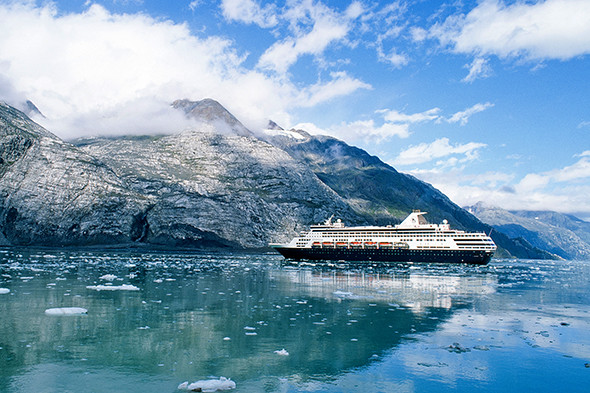 |
| To Cruise, or Not to Cruise? |
What’s new in the cruise industry?
Ships from mainstream lines continue to break size barriers as they compete against megaresorts on terra firma, with giant slides, skydiving simulators, and cooking classes.
If you enjoy Orlando’s Disney World or Nassau’s Atlantis resort, megaliners such as the 5,479-passenger Harmony of the Seas can dazzle. Increasingly, major lines enlist outside brands to sell their experience: Royal Caribbean offers Starbucks, Carnival offers Guy Fieri burgers, and Norwegian lures with Broadway shows like Legally Blonde.
But size isn’t everything. There also is action on the boutique and luxury side, most notably with the arrival of Viking Ocean Cruises in 2015. “Viking already has 50 percent of the river cruise business, and now they’re really shaking things up with their oceangoing line,” explains Gene Sloan, travel and cruise editor for USA Today.
“They’re catering to an underserved niche with more intimate smaller ships,” Sloan says. “Viking is more upscale than the big mass-market lines, yet not as expensive as the superluxury lines.”
Virgin Cruises, due to launch in 2020, may prove to be another game changer.
The industry also is capitalizing on the solo cruiser market. Cunard, Norwegian, Royal Caribbean, and Holland America are building (or adapting existing) ships with a few smaller cabins for single occupancy.
I think I’m prone to seasickness. Are cruises a bad idea?
Most modern ships are well stabilized, but if you’re concerned, such over-the-counter meds as Dramamine are remedies for mild cases, while Transderm Scop, a prescription patch, is another solution.
Another tip: Book a cabin closer to the middle of the ship, where rocking and rolling will be less pronounced.
Also, consider cruising the calmer waters of Alaska’s Inside Passage or the fjords of Norway. The Caribbean is more placid outside of hurricane season; during those months, captains can steer clear of major weather systems.
Is a balcony worth springing for?
Almost everyone covets a private veranda. Such demand means balcony cabins cost considerably more than an identical “ocean view” cabin with a window. But note that verandas are shrinking: The newer ships from Princess and Norwegian have balconies that are less than four feet deep. If you’re headed on an itinerary where port days will be long and intensive, you’ll have little time to spend on the balcony.
The bottom line: If cost is a concern, decide whether your cruise is about the destination or the seagoing experience.
“Inside” cabins are also evolving. A new option on several Royal Caribbean ships is “virtual balconies”—a floor-to-ceiling, high-definition screen (instead of a window) that displays real-time views of the sea. Inside cabins aboard Disney’s Dream and Fantasy feature faux portholes offering virtual sightings of animated Disney characters.
Are cruises all-inclusive?
Most amenities that were included in a cruise fare a few decades ago are still there, but opportunities for spending money have multiplied. Tipping—once optional—is now mandatory, with per-person, per-day costs of $12 or more often added to the checkout bill, plus service charges of 15 to 18 percent for all drink orders.
With most mass-market cruise lines, anticipate add-ons for Internet, drinks, upgraded coffee, and such specialized exercise classes as spinning. Some ships boast a dozen or more dining options, but most will incur a surcharge of $20, $40, or more.
Carnival and Norwegian rocked the boat last year when they began charging for room service meals—long a standard of cruising. Several lines have designated some outdoor deck areas as fee-added options, meaning we now pay for elbow room.
“On the low end, there’s definitely more nickel-and-diming in recent years,” says Sloan. “And the gratuity charges have really gotten out of control.” High-end cruises waive most or all of these add-ons, though fares can easily top $500 per person per day.
Yet if you avoid the add-ons, cruising can be an excellent value, especially for families.
If you’re not too fussy with dates or itinerary, and book close to the time of departure, it’s possible to find an ocean-view cabin in summer on a Mediterranean cruise for not much more than $100 per night per person, including meals and entertainment. And how many resorts in the Med can compete with that in high season?
What new geographical areas are cruise lines exploring?
Cruises to Asia, Australia, and New Zealand are on the rise.
Ships also are venturing north of the Arctic Circle; the National Geographic Explorer offers the “Epic 80°N” cruise to Baffin Island, Ellesmere Island, and Greenland.
Multicontinent cruises also have become popular, often selling out many months in advance. For sheer value, though, such tried-and-true regions as the Caribbean, Europe, and Alaska may prove the best bet for the best deals.
More exotic cruise itineraries tend to draw experienced passengers who are willing to pay a premium to enjoy new vistas and experiences.
This piece, by David Swanson, appeared in the February/March 2016 issue of National Geographic Traveler magazine.
Source: http://intelligenttravel.nationalgeographic.com/2016/02/23/to-cruise-or-not-to-cruise/
No comments:
Post a Comment